On the Enhancement of the Long-Term Washability of e-Textile Realized with Electrically Conductive Graphene-Based Inks
Abstract
1. Introduction
2. Materials and Methods
2.1. Fourier-Transform Infrared Spectroscopy (FT-IR) Analysis
2.2. Wettability Properties
2.3. Scanning Electron Microscopy Analysis (SEM)
2.4. Atomic Force Microscopy Analysis (AFM)
2.5. Tensile Tests
2.6. Electrical Resistance, Resistivity, and Washability Tests
2.7. Piezoresistive Characterization
2.8. Measurement Chain for ECG Signal Acquisition
3. Results and Discussion
3.1. FT-IR Analysis
3.2. Morphological and Topographical Analysis
3.3. Wettability Properties
3.4. Tensile Tests
3.5. Electrical Analysis
3.6. Piezoresistive and ECG Signal Acquisition Performance
4. Conclusions
Supplementary Materials
Author Contributions
Funding
Institutional Review Board Statement
Data Availability Statement
Acknowledgments
Conflicts of Interest
References
- Wei, B.; Yang, N.; Tian, M.; Qu, L.; Zhu, S. Effect of Coating Methods on Thermal Conductivity of Graphene-Coated Fabrics for Welding Protective Clothing. Mater. Lett. 2022, 314, 131787. [Google Scholar] [CrossRef]
- Sajovic, I.; Kert, M.; Boh Podgornik, B. Smart Textiles: A Review and Bibliometric Mapping. Appl. Sci. 2023, 13, 10489. [Google Scholar] [CrossRef]
- Eghan, B.; Ofori, E.A.; Kanyire, R.; Tawiah, B.; Acquaye, R. Systematic Review of Conductive Inks for E-Textiles: Formulation, Printing Methods, Challenges, and Opportunities. AATCC J. Res. 2025, 12, 1–17. [Google Scholar] [CrossRef]
- Islam, M.R.; Afroj, S.; Beach, C.; Islam, M.H.; Parraman, C.; Abdelkader, A.; Casson, A.J.; Novoselov, K.S.; Karim, N. Fully Printed and Multifunctional Graphene-Based Wearable e-Textiles for Personalized Healthcare Applications. iScience 2022, 25, 103945. [Google Scholar] [CrossRef] [PubMed]
- Hong, H.; Jiyong, H.; Moon, K.S.; Yan, X.; Wong, C. ping Rheological Properties and Screen Printability of UV Curable Conductive Ink for Flexible and Washable E-Textiles. J. Mater. Sci. Technol. 2021, 67, 145–155. [Google Scholar] [CrossRef]
- Xu, X.; Luo, M.; He, P.; Guo, X.; Yang, J. Screen Printed Graphene Electrodes on Textile for Wearable Electrocardiogram Monitoring. Appl. Phys. A 2019, 125, 714. [Google Scholar] [CrossRef]
- Lee, C.; Wei, X.; Kysar, J.W.; Hone, J. Measurement of the Elastic Properties and Intrinsic Strength of Monolayer Graphene. Science 2008, 321, 385–388. [Google Scholar] [CrossRef] [PubMed]
- Tadakaluru, S.; Thongsuwan, W.; Singjai, P. Stretchable and Flexible High-Strain Sensors Made Using Carbon Nanotubes and Graphite Films on Natural Rubber. Sensors 2014, 14, 868–876. [Google Scholar] [CrossRef]
- Jiang, L.; Hong, H.; Hu, J. Facile Thermoplastic Polyurethane-Based Multi-Walled Carbon Nanotube Ink for Fabrication of Screen-Printed Fabric Electrodes of Wearable e-Textiles with High Adhesion and Resistance Stability under Large Deformation. Text. Res. J. 2021, 91, 2487–2499. [Google Scholar] [CrossRef]
- Cui, T.R.; Li, D.; Huang, X.R.; Yan, A.Z.; Dong, Y.; Xu, J.D.; Guo, Y.Z.; Wang, Y.; Chen, Z.K.; Shao, W.C.; et al. Graphene-Based Flexible Electrode for Electrocardiogram Signal Monitoring. Appl. Sci. 2022, 12, 4526. [Google Scholar] [CrossRef]
- Libanori, A.; Chen, G.; Zhao, X.; Zhou, Y.; Chen, J. Smart Textiles for Personalized Healthcare. Nat. Electron. 2022, 5, 142–156. [Google Scholar] [CrossRef]
- Amitrano, F.; Coccia, A.; Ricciardi, C.; Donisi, L.; Cesarelli, G.; Capodaglio, E.M.; D’Addio, G. Design and Validation of an E-Textile-Based Wearable Sock for Remote Gait and Postural Assessment. Sensors 2020, 20, 6691. [Google Scholar] [CrossRef] [PubMed]
- Cesarelli, G.; Donisi, L.; Coccia, A.; Amitrano, F.; D’Addio, G.; Ricciardi, C. The E-Textile for Biomedical Applications: A Systematic Review of Literature. Diagnostics 2021, 11, 2263. [Google Scholar] [CrossRef]
- Islam, M.R.; Afroj, S.; Yin, J.; Novoselov, K.S.; Chen, J.; Karim, N. Advances in Printed Electronic Textiles. Adv. Sci. 2024, 11, e2304140. [Google Scholar] [CrossRef] [PubMed]
- Cataldi, P.; Steiner, P.; Liu, M.; Pinter, G.; Athanassiou, A.; Kocabas, C.; Kinloch, I.A.; Bissett, M.A. A Green Electrically Conductive Textile with Tunable Piezoresistivity and Transiency. Adv. Funct. Mater. 2023, 33, 2301542. [Google Scholar] [CrossRef]
- Cao, R.; Pu, X.; Du, X.; Yang, W.; Wang, J.; Guo, H.; Zhao, S.; Yuan, Z.; Zhang, C.; Li, C.; et al. Screen-Printed Washable Electronic Textiles as Self-Powered Touch/Gesture Tribo-Sensors for Intelligent Human–Machine Interaction. ACS Nano 2018, 12, 5190–5196. [Google Scholar] [CrossRef]
- Azani, M.R.; Hassanpour, A. Electronic Textiles (E-Textiles): Types, Fabrication Methods, and Recent Strategies to Overcome Durability Challenges (Washability & Flexibility); Springer: Greer, SC, USA, 2024; Volume 35, ISBN 0-123-45678-9. [Google Scholar]
- Navidfar, A.; Saad, S.A.S.; Caylak, S.; Trabzon, L. A Green Approach to Prepare Graphene-Coated Flexible and Conductive Cotton Fabrics for Motion Sensing. J. Mater. Sci. 2025, 60, 2878–2888. [Google Scholar] [CrossRef]
- Htwe, Y.Z.N.; Mariatti, M. Printed Graphene and Hybrid Conductive Inks for Flexible, Stretchable, and Wearable Electronics: Progress, Opportunities, and Challenges. J. Sci. Adv. Mater. Devices 2022, 7, 100435. [Google Scholar] [CrossRef]
- Huang, Q.; Zhu, Y. Printing Conductive Nanomaterials for Flexible and Stretchable Electronics: A Review of Materials, Processes, and Applications. Adv. Mater. Technol. 2019, 4, 1800546. [Google Scholar] [CrossRef]
- Abdi, B.; Tarhini, A.; Baniasadi, H.; Tehrani-Bagha, A.R. Developing Graphene-Based Conductive Textiles Using Different Coating Methods. Adv. Mater. Technol. 2024, 9, 2301492. [Google Scholar] [CrossRef]
- Rotzler, S.; Schneider-Ramelow, M. Washability of E-Textiles: Failure Modes and Influences on Washing Reliability. Textiles 2021, 1, 37–54. [Google Scholar] [CrossRef]
- Maizal Hairi, N.I.I.; Md Ralib, A.A.; Nordin, A.N.; Mohamad Yunos, M.F.A.; Ming, L.L.; Tung, L.H.; Samsudin, Z. Recent Advance in Using Eco-Friendly Carbon-Based Conductive Ink for Printed Strain Sensor: A Review. Clean. Mater. 2024, 12, 100248. [Google Scholar] [CrossRef]
- Zhang, Y.; Zhu, Y.; Zheng, S.; Zhang, L.; Shi, X.; He, J.; Chou, X.; Wu, Z.S. Ink Formulation, Scalable Applications and Challenging Perspectives of Screen Printing for Emerging Printed Microelectronics. J. Energy Chem. 2021, 63, 498–513. [Google Scholar] [CrossRef]
- Boumegnane, A.; Nadi, A.; Cochrane, C.; Boussu, F.; Cherkaoui, O.; Tahiri, M. Formulation of Conductive Inks Printable on Textiles for Electronic Applications: A Review. Text. Prog. 2022, 54, 103–200. [Google Scholar] [CrossRef]
- Somarathna, U.S.; Garakani, B.; Weerawarne, D.L.; Alhendi, M.; Poliks, M.D.; Misner, M.; Burns, A.; Khinda, G.S.; Alizadeh, A. Reliability of Screen-Printed Water-Based Carbon Resistors for Sustainable Wearable Sensors. IEEE Sens. J. 2025, 25, 6449–6463. [Google Scholar] [CrossRef]
- Tian, S. Recent Advances in Functional Polyurethane and Its Application in Leather Manufacture: A Review. Polymers 2020, 12, 1996. [Google Scholar] [CrossRef] [PubMed]
- Elmogahzy, Y.; Farag, R. 7—Tensile Properties of Cotton Fibers: Importance, Research, and Limitations. In Handbook of Properties of Textile and Technical Fibres, 2nd ed.; Bunsell, A.R., Ed.; The Textile Institute Book Series; Woodhead Publishing: Sawston, UK, 2018; pp. 223–273. ISBN 978-0-08-101272-7. [Google Scholar]
- ISO 6330:2012; Textiles—Domestic Washing and Drying Procedures for Textile Testing. International Organization for Standardization: Geneva, Switzerland, 2012.
- Rollo, G.; Ronca, A.; Cerruti, P.; Xia, H.; Gruppioni, E.; Lavorgna, M. Optimization of Piezoresistive Response of Elastomeric Porous Structures Based on Carbon-Based Hybrid Fillers Created by Selective Laser Sintering. Polymers 2023, 15, 4404. [Google Scholar] [CrossRef]
- Liu, J.; Lama, G.C.; Recupido, F.; Santillo, C.; Gentile, G.; Buonocore, G.G.; Verdolotti, L.; Zhang, X.; Lavorgna, M. A Multifunctional Composite Material with Piezoresistivity and Mechanoluminescence Properties for a Wearable Sensor. Compos. Sci. Technol. 2023, 236, 109993. [Google Scholar] [CrossRef]
- Alblalaihid, K.S.; Aldoihi, S.A.; Alharbi, A.A. Structural Health Monitoring of Fiber Reinforced Composites Using Integrated a Linear Capacitance Based Sensor. Polymers 2024, 16, 1560. [Google Scholar] [CrossRef]
- Rollo, G.; Ronca, A.; Cerruti, P.; Gan, X.P.; Fei, G.; Xia, H.; Gorokhov, G.; Bychanok, D.; Kuzhir, P.; Lavorgna, M. On the Synergistic Effect of Multi-Walled Carbon Nanotubes and Graphene Nanoplatelets to Enhance the Functional Properties of SLS 3D-Printed Elastomeric Structures. Polymers 2020, 12, 1841. [Google Scholar] [CrossRef]
- Silva, H.; Guerreiro, J.; Lourenço, A.; Fred, A.L.N.; Martins, R. BITalino: A Novel Hardware Framework for Physiological Computing. In Proceedings of the International Conference on Physiological Computing Systems, Lisbon, Portugal, 7–9 January 2014. [Google Scholar]
- Snyder, R.G.; Hsu, S.L.; Krimm, S. Vibrational Spectra in the C-H Stretching Region and the Structure of the Polymethylene Chain. Spectrochim. Acta Part A Mol. Spectrosc. 1978, 34, 395–406. [Google Scholar] [CrossRef]
- Kaminski, A.M.; Urban, M.W.; Part, I. Interfacial Studies of Crosslinked Polyurethanes; Part I. Quantitative and Structural Aspects of Crosslinking near Film-Air and Film-Substrate Interfaces in Solvent-Borne Polyurethanes. J. Coat. Technol. 1997, 69, 55–66. [Google Scholar] [CrossRef]
- Choong, P.S.; Rusli, W.; Seayad, A.M.; Seayad, J.; Jana, S. Crosslinked Succinic Acid Based Non-Isocyanate Polyurethanes for Corrosion Resistant Protective Coatings. Prog. Org. Coat. 2024, 186, 107961. [Google Scholar] [CrossRef]
- Orgilés-Calpena, E.; Arán-Aís, F.; Torró-Palau, A.M.; Orgilés-Barceló, C.; Martín-Martínez, J.M. Addition of Different Amounts of a Urethane-Based Thickener to Waterborne Polyurethane Adhesive. Int. J. Adhes. Adhes. 2009, 29, 309–318. [Google Scholar] [CrossRef]
- Wilhelm, C.; Gardette, J.-L. Infrared Analysis of the Photochemical Behaviour of Segmented Polyurethanes: 1. Aliphatic Poly(Ester-Urethane). Polymer 1997, 38, 4019–4031. [Google Scholar] [CrossRef]
- Lee, W.-J.; Chao, C.-Y. Effect of Containing Polyhydric Alcohol Liquefied Wood on the Properties of Thermoplastic Polyurethane Resins. Eur. J. Wood Wood Prod. 2018, 76, 1745–1752. [Google Scholar] [CrossRef]
- Bueno-Ferrer, C.; Hablot, E.; del Carmen Garrigós, M.; Bocchini, S.; Averous, L.; Jiménez, A. Relationship between Morphology, Properties and Degradation Parameters of Novative Biobased Thermoplastic Polyurethanes Obtained from Dimer Fatty Acids. Polym. Degrad. Stab. 2012, 97, 1964–1969. [Google Scholar] [CrossRef]
- Nielsen, L.E. Cross-Linking–Effect on Physical Properties of Polymers. J. Macromol. Sci. Part C 1969, 3, 69–103. [Google Scholar] [CrossRef]
- Yoshimitsu, Z.; Nakajima, A.; Watanabe, T.; Hashimoto, K. Effects of Surface Structure on the Hydrophobicity and Sliding Behavior of Water Droplets. Langmuir 2002, 18, 5818–5822. [Google Scholar] [CrossRef]
- Herrera, M.; Matuschek, G.; Kettrup, A. Thermal Degradation of Thermoplastic Polyurethane Elastomers (TPU) Based on MDI. Polym. Degrad. Stab. 2002, 78, 323–331. [Google Scholar] [CrossRef]
- Barros Junior, L.P.; de Souza, L.R.; Rahimzadeh, R.; Manas-Zloczower, I. Improving Performance of TPU by Controlled Crosslinking of Soft Segments. Polym. Eng. Sci. 2024, 64, 3982–3992. [Google Scholar] [CrossRef]
- Karbach, A.; Drechsler, D. Atomic Force Microscopy—A Powerful Tool for Industrial Applications. Surf. Interface Anal. 1999, 27, 401–409. [Google Scholar] [CrossRef]
- Song, X.; Ji, J.; Zhou, N.; Chen, M.; Qu, R.; Li, H.; Zhang, L.; Ma, S.; Ma, Z.; Wei, Y. Stretchable Conductive Fibers: Design, Properties and Applications. Prog. Mater. Sci. 2024, 144, 101288. [Google Scholar] [CrossRef]
- Wiklund, J.; Karakoç, A.; Palko, T.; Yigitler, H.; Ruttik, K.; Jäntti, R.; Paltakari, J. A Review on Printed Electronics: Fabrication Methods, Inks, Substrates, Applications and Environmental Impacts. J. Manuf. Mater. Process. 2021, 5, 89. [Google Scholar] [CrossRef]
- Krifa, M. Electrically Conductive Textile Materials—Application in Flexible Sensors and Antennas. Textiles 2021, 1, 239–257. [Google Scholar] [CrossRef]
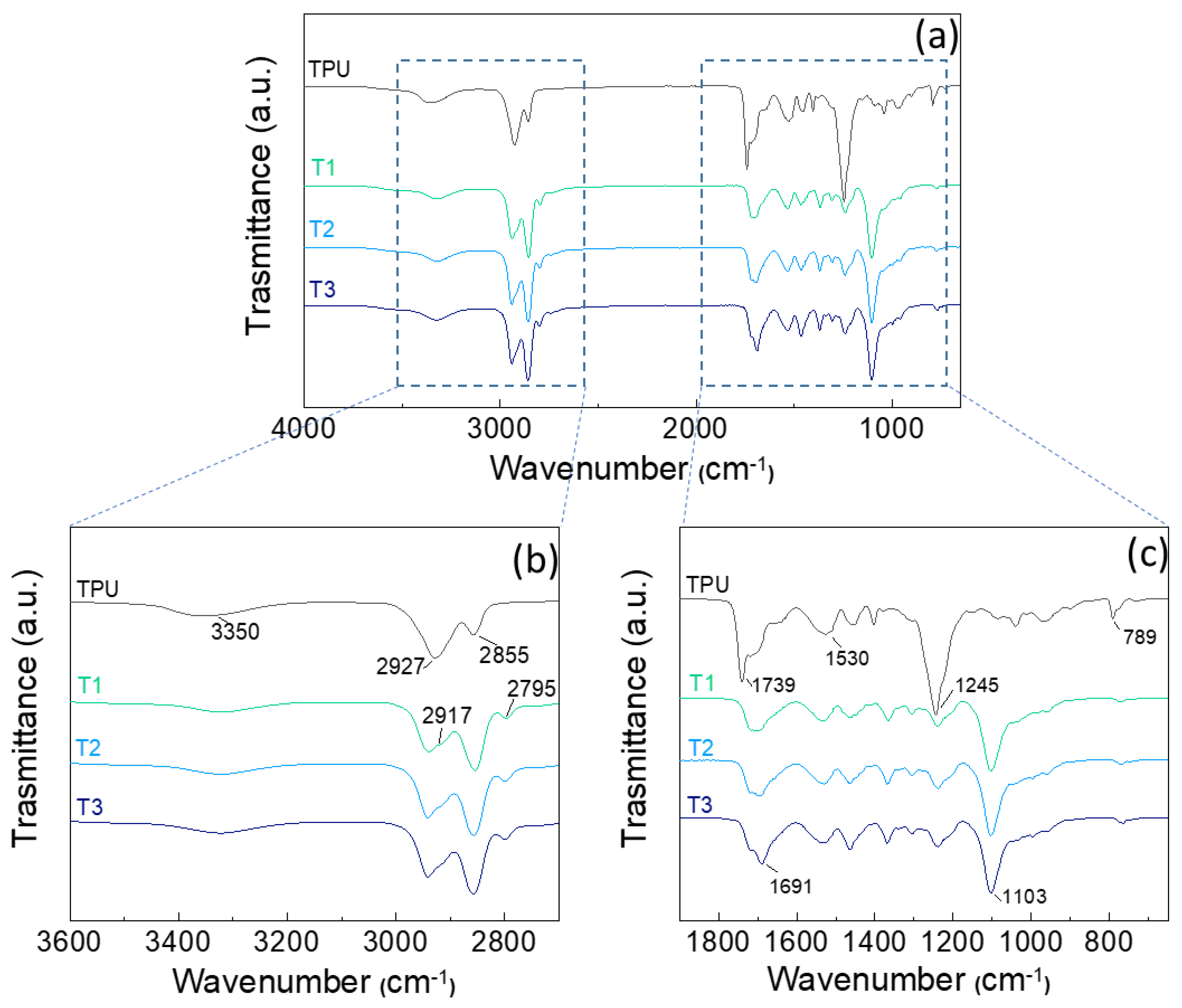

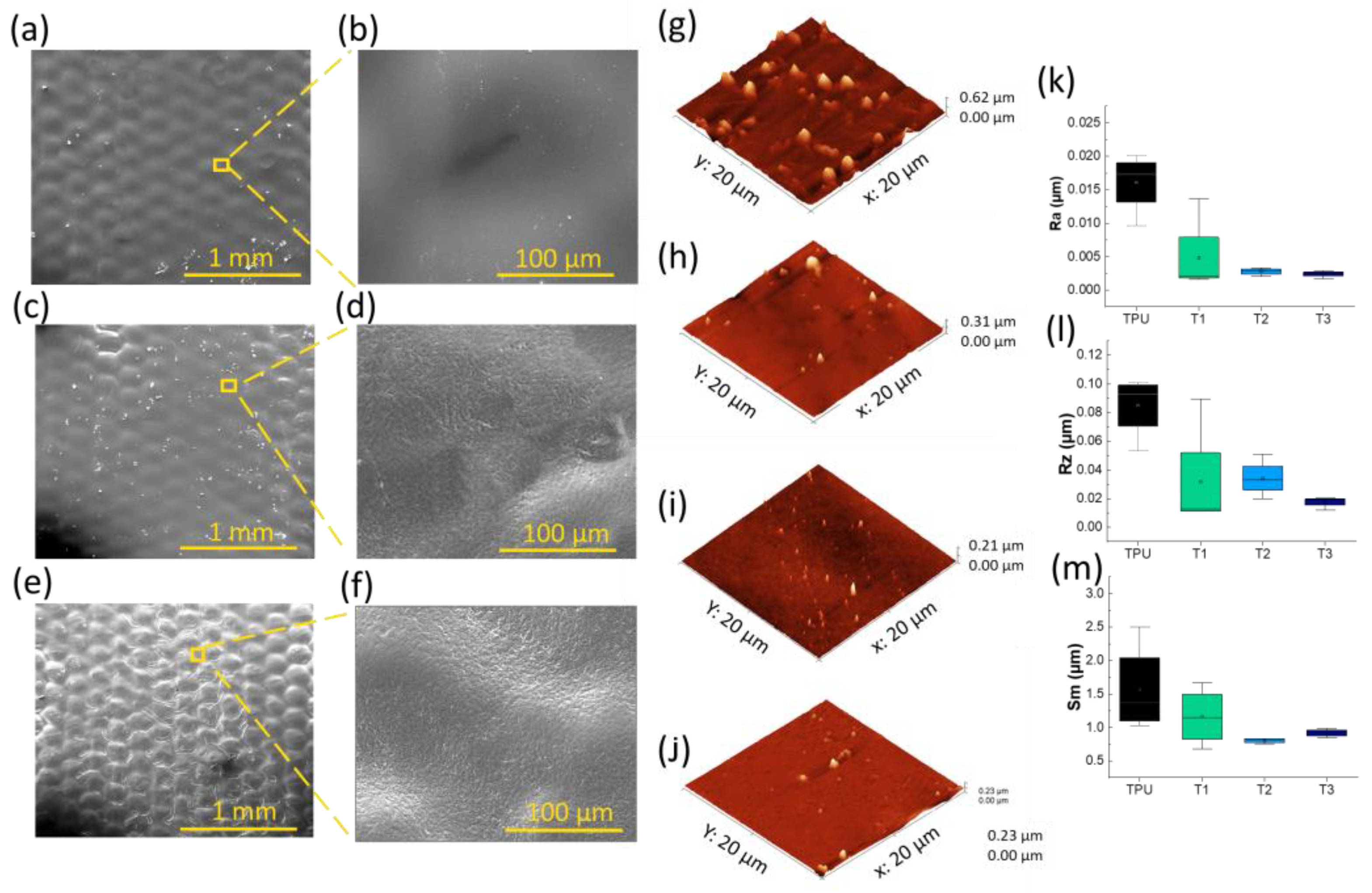

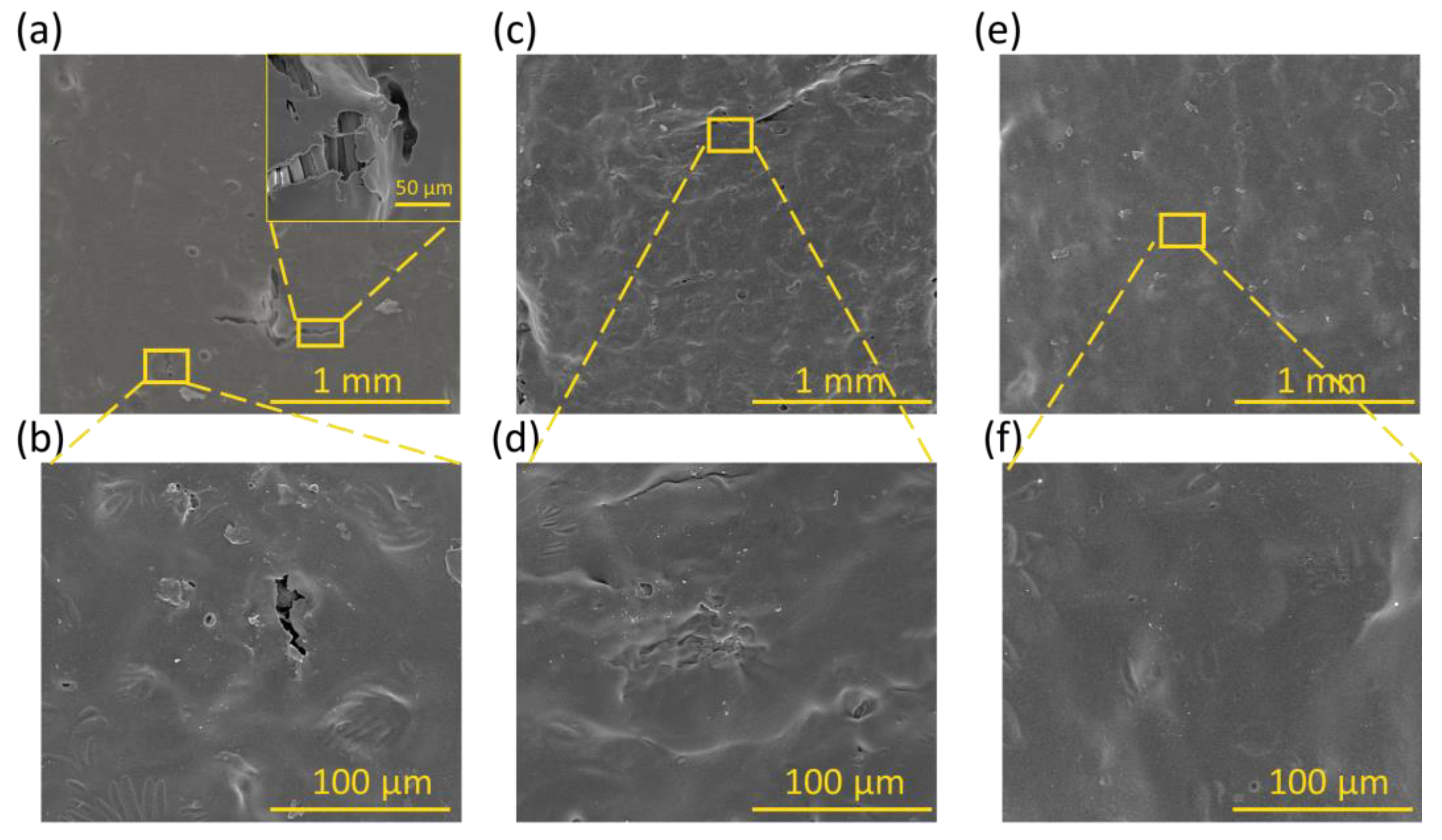

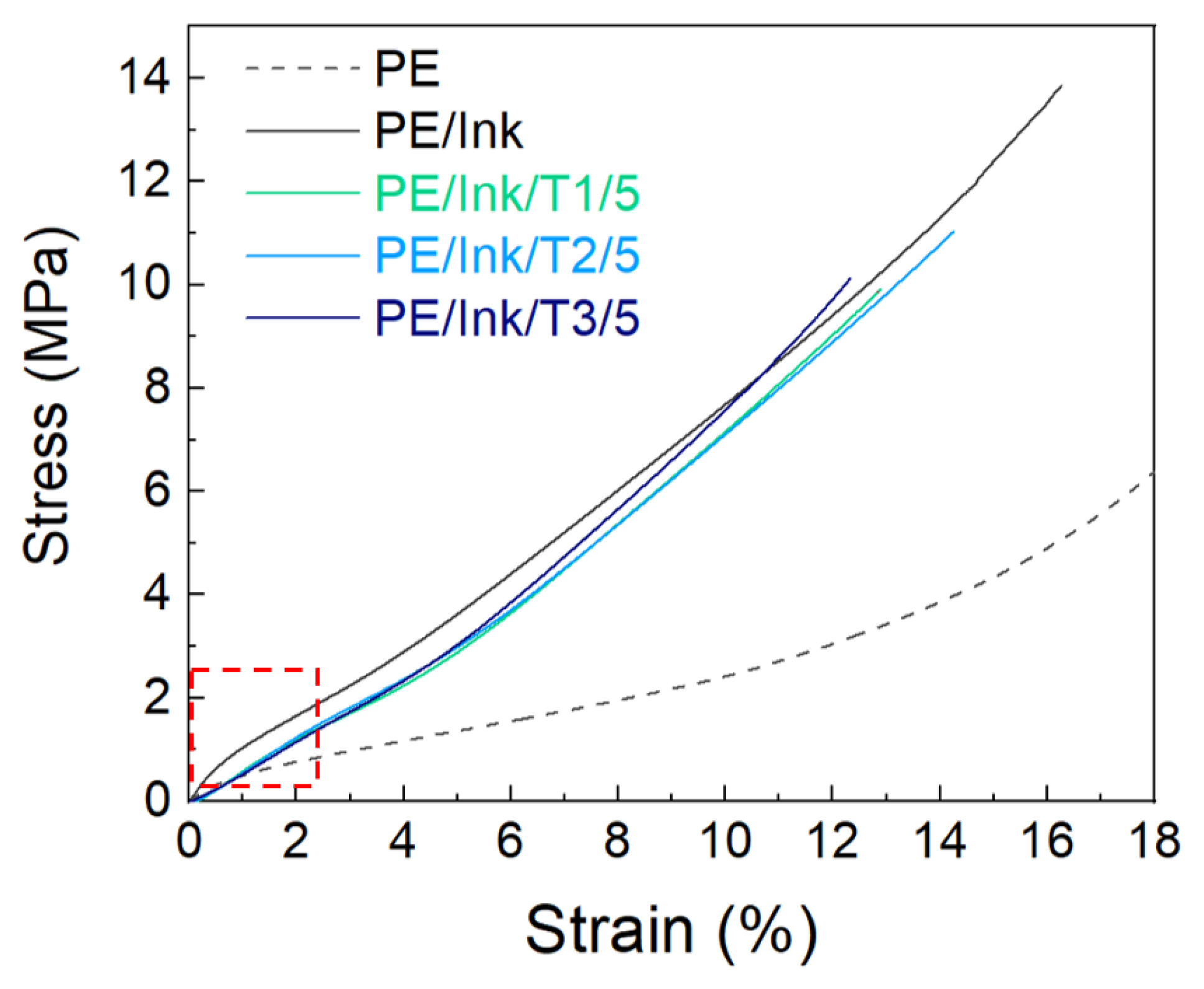
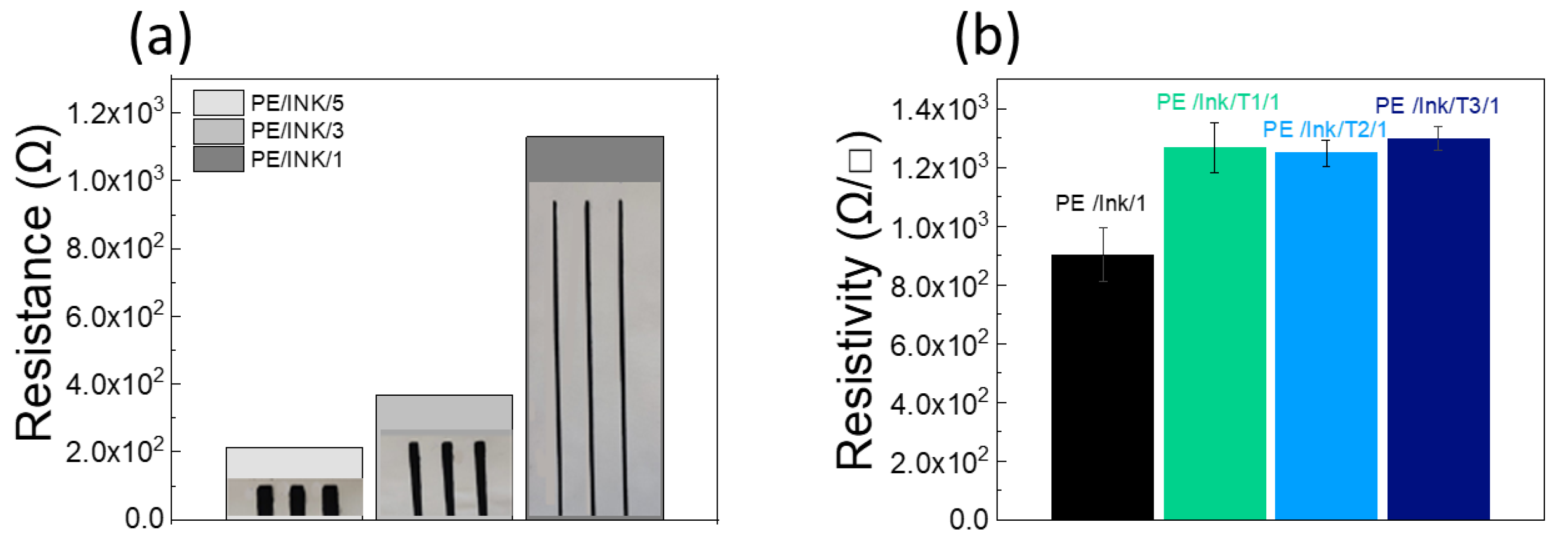
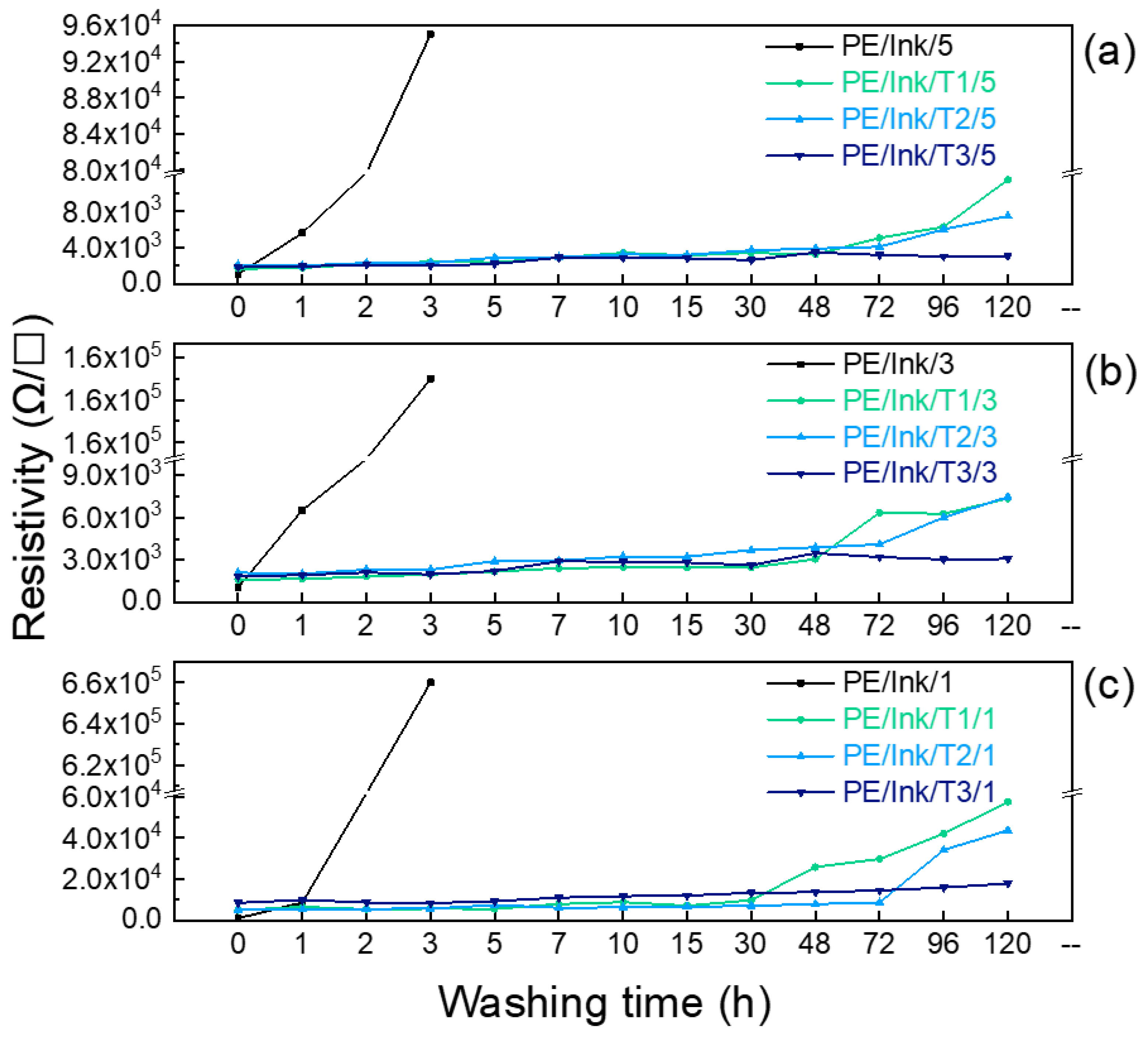

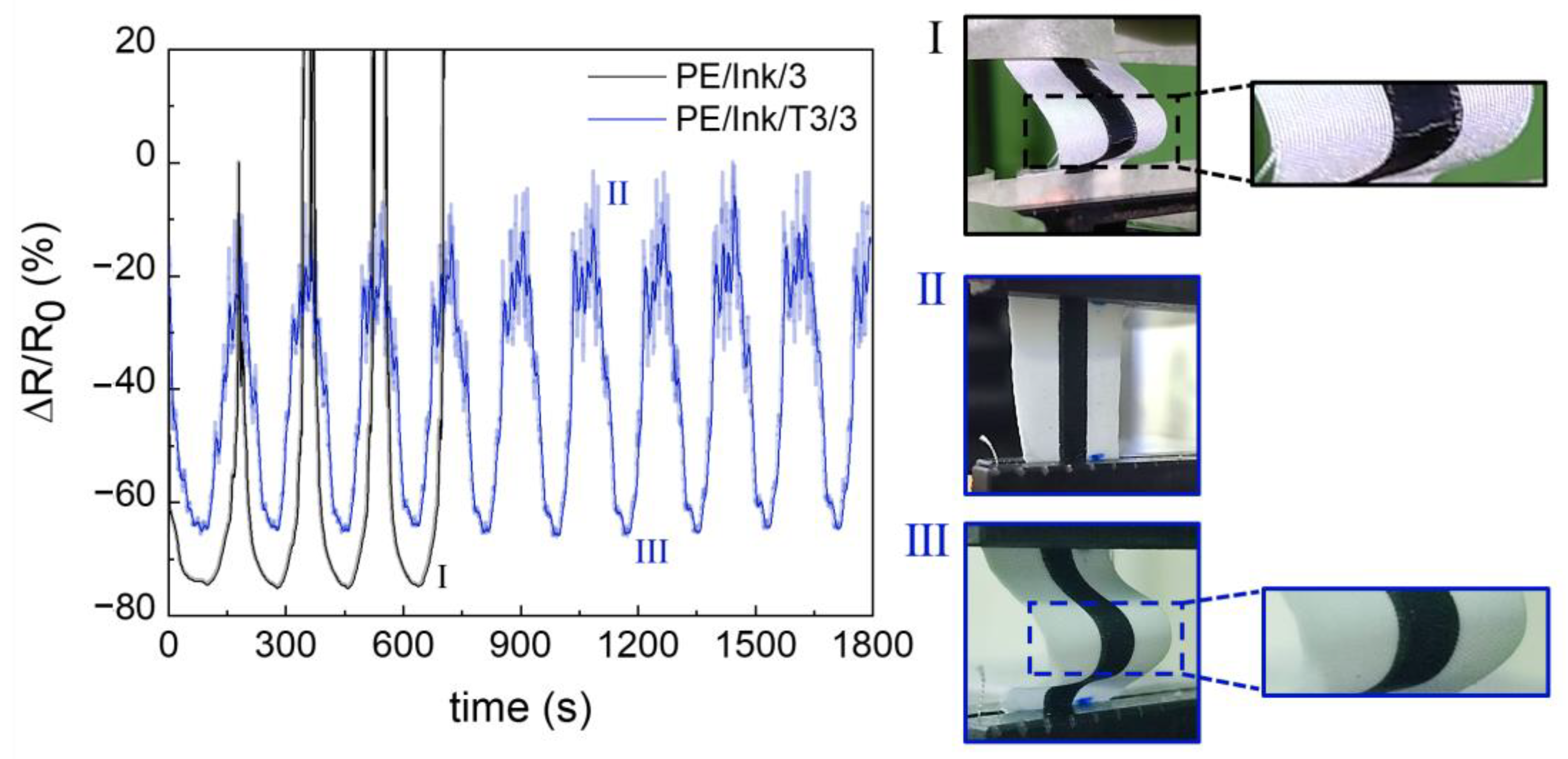
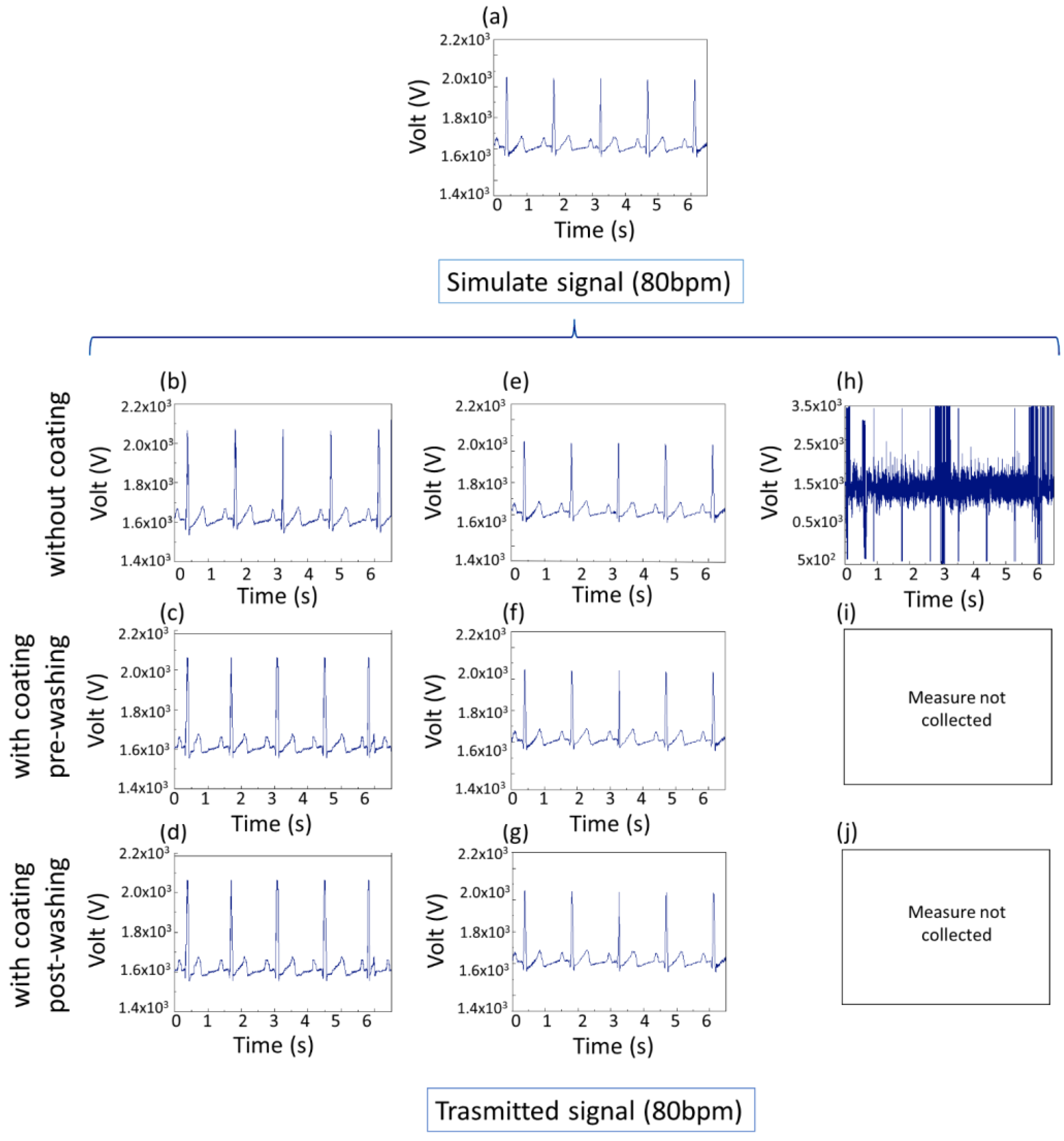
| Coating Name | Crosslinker (wt%) | Thickener (wt%) |
|---|---|---|
| T1 | 2 | 2.5 |
| T2 | 2.5 | 2.5 |
| T3 | 6 | 3 |
| Sample | Tensile Modulus (MPa) | Tensile Strength * (MPa) | Ultimate Strain * (%) |
|---|---|---|---|
| PE | 20.2 ± 8.7 | 6.2 ± 2.0 | 17.8 ± 2.7 |
| PE/Ink | 81.1 ± 0.9 | 13.8 ± 5.1 | 16.3 ± 0.6 |
| PE/Ink/T1/5 | 86.5 ± 8.7 | 9.8 ± 1.3 | 13.0 ± 1.7 |
| PE/Ink/T2/5 | 83.0 ± 13.4 | 11.0 ± 2.6 | 14.3 ± 0.9 |
| PE/Ink/T3/5 | 90.5 ± 6.1 | 10.1 ± 0.4 | 12.3 ± 0.3 |
Disclaimer/Publisher’s Note: The statements, opinions and data contained in all publications are solely those of the individual author(s) and contributor(s) and not of MDPI and/or the editor(s). MDPI and/or the editor(s) disclaim responsibility for any injury to people or property resulting from any ideas, methods, instructions or products referred to in the content. |
© 2025 by the authors. Licensee MDPI, Basel, Switzerland. This article is an open access article distributed under the terms and conditions of the Creative Commons Attribution (CC BY) license (https://creativecommons.org/licenses/by/4.0/).
Share and Cite
Improta, I.; Rollo, G.; Buonocore, G.G.; Del Ferraro, S.; Molinaro, V.; D’Addio, G.; De Rosa, A.; Lavorgna, M. On the Enhancement of the Long-Term Washability of e-Textile Realized with Electrically Conductive Graphene-Based Inks. Polymers 2025, 17, 904. https://doi.org/10.3390/polym17070904
Improta I, Rollo G, Buonocore GG, Del Ferraro S, Molinaro V, D’Addio G, De Rosa A, Lavorgna M. On the Enhancement of the Long-Term Washability of e-Textile Realized with Electrically Conductive Graphene-Based Inks. Polymers. 2025; 17(7):904. https://doi.org/10.3390/polym17070904
Chicago/Turabian StyleImprota, Ilaria, Gennaro Rollo, Giovanna Giuliana Buonocore, Simona Del Ferraro, Vincenzo Molinaro, Gianni D’Addio, Anna De Rosa, and Marino Lavorgna. 2025. "On the Enhancement of the Long-Term Washability of e-Textile Realized with Electrically Conductive Graphene-Based Inks" Polymers 17, no. 7: 904. https://doi.org/10.3390/polym17070904
APA StyleImprota, I., Rollo, G., Buonocore, G. G., Del Ferraro, S., Molinaro, V., D’Addio, G., De Rosa, A., & Lavorgna, M. (2025). On the Enhancement of the Long-Term Washability of e-Textile Realized with Electrically Conductive Graphene-Based Inks. Polymers, 17(7), 904. https://doi.org/10.3390/polym17070904








